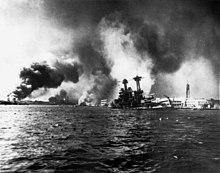Tennessee class (battleship)
|
|
|
|---|---|

|
|
| Tennessee class | |
| Type: | Battleship |
| Identification numbers: | BB-43 to BB-44 |
| Predecessor: | New Mexico class |
| Successor: | Colorado class |
| Ships: | USS Tennessee (BB-43) , USS California (BB-44) |
| career | |
| Keel laying |
BB-43 : May 14, 1917 BB-44 : October 25, 1916 |
| Commissioning |
BB-43 : June 3, 1920 BB-44 : October 8, 1921 |
| Decommissioning |
BB-43 : February 14, 1947 BB-44 : August 7, 1946 |
| Whereabouts: | Reserve until March 1, 1959, then scrapped |
| Technical specifications | |
| displacement | 33,190 tons |
| length | 190.00 m |
| width | 29.6 meters |
| Draft: | 9.4 m |
| Top speed: | 21 kn |
| Crew: | 1083 |
| Armament: |
|
The Tennessee-class was a class of United States Navy battleships before and during World War II that consisted of the USS Tennessee (BB-43) and the USS California (BB-44) .
The ships of this class were the first battleships to be built with a new structure, which took into account the experience gained from the first half of the First World War , in particular from the Battle of the Skagerrak . As a result of numerous tests and calculations, the underwater armor was significantly stronger than that of previous battleships. The ships of the Tennessee class and the almost identical Colorado class that followed are now considered to be the US battleships with the best underwater protection, since the system developed to protect against torpedo hits consists of several empty or liquid-filled chambers in the later ones , the narrow hulls of the fast battleships designed for high speed could no longer be installed.
Another advantage compared to earlier ships was the ability to point the heavy artillery up to 30 degrees, about twice as high as before. This increased the range dramatically and the ships could shoot far over the horizon . This made it possible to take full advantage of the reconnaissance aircraft that are now becoming standard. Otherwise, the main battery consisted of twelve 14- in - (356-mm) guns in four triplet turrets, as in the previous ships of the Pennsylvania and New Mexico class . Fourteen 5-inch (127-mm) guns of caliber length 51 against sea targets were installed in casemates as secondary batteries , and for the first time both the main and secondary guns were given their own fire control stations. Strong anti-aircraft armament was installed with eight 25-caliber 5-inch guns, which replaced the older 3-inch (76.2 mm) Flak guns.
Due to their characteristic appearance with the two large lattice masts, they were known in the population together with the ships of the Colorado class as the Big Five .
Both ships of the class were in the port of Pearl Harbor on December 7, 1941 . In the Japanese attack on Pearl Harbor , the Tennessee was damaged and the California sunk, but it was later raised again in March 1942. In the course of the repair work, the ships were completely overhauled: their structure was completely changed, the armor reinforced and greater stability made possible in bad seas. In addition, the existing different 5-inch guns were removed and replaced by a single unitary battery of new 5-inch multi-purpose guns of caliber length 38 in twin turrets, which were equally suitable for combating sea and air targets. The lattice masts were completely removed.
There were combat missions for the ships, among other things, in the battle for Guam , Okinawa or the battles with the Aleutians . The battleships mostly provided fire protection for the landing troops and destroyed bunkers, guns and blocked airfields. The Tennessee was involved in the last battleship clash in history at the Battle of Surigao Strait during the sea and air battles of Leyte Gulf .
The Tennessee class was part of the "standard type battleship" concept of the USA, which provided for a relative uniformity of the battleships in order to simplify maneuvers. For example, different tactics and configurations did not have to be developed in order to adapt them to different armaments and speeds. In addition, the tactics could be standardized and transferred to other classes. The other classes of this concept were the Nevada class , Pennsylvania class , New Mexico class, and the Colorado class .
The US theory, which was heavily influenced by Alfred Thayer Mahan , saw it as more important to have strong armament, since the enemy would have to face the Americans in any case to advance on important targets and would then be defeated by the superior firepower. Chasing and chasing enemy battleships played only a minor role.
Web links
- Tennessee class at history.navy.mil (English)

